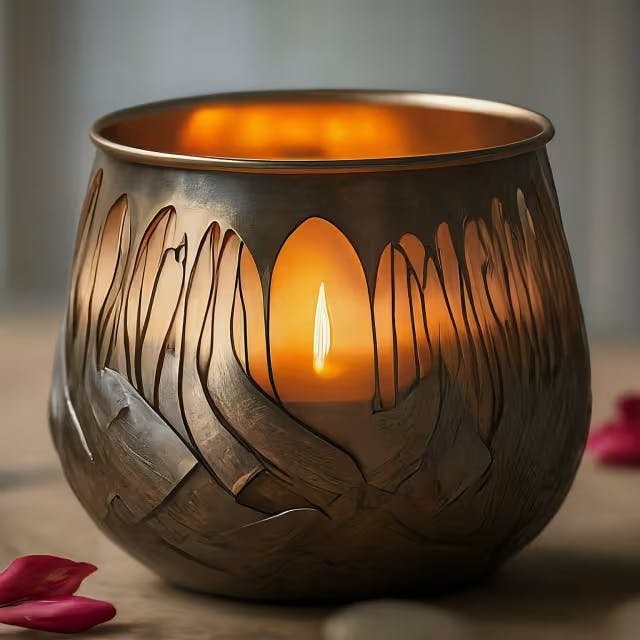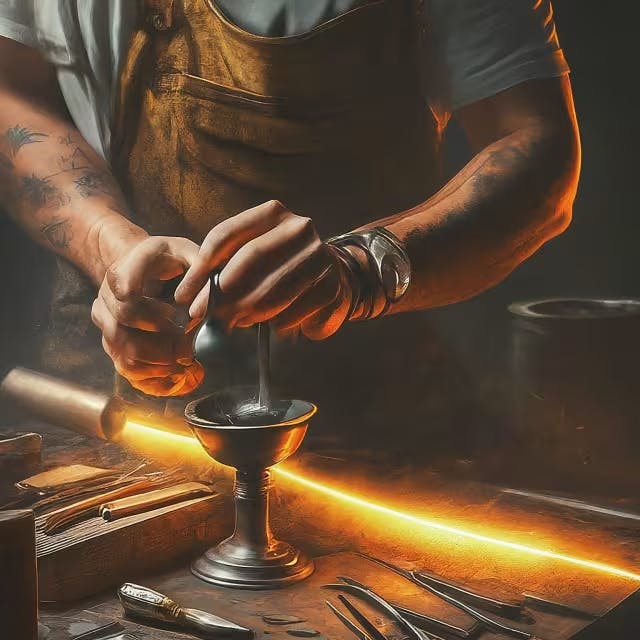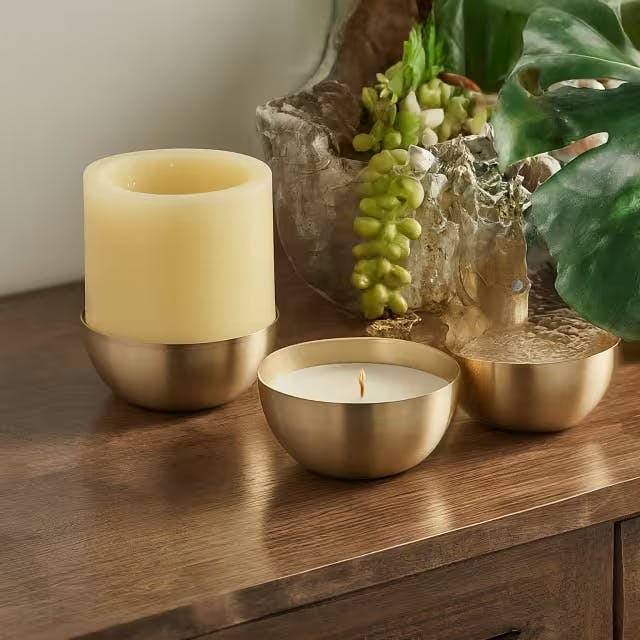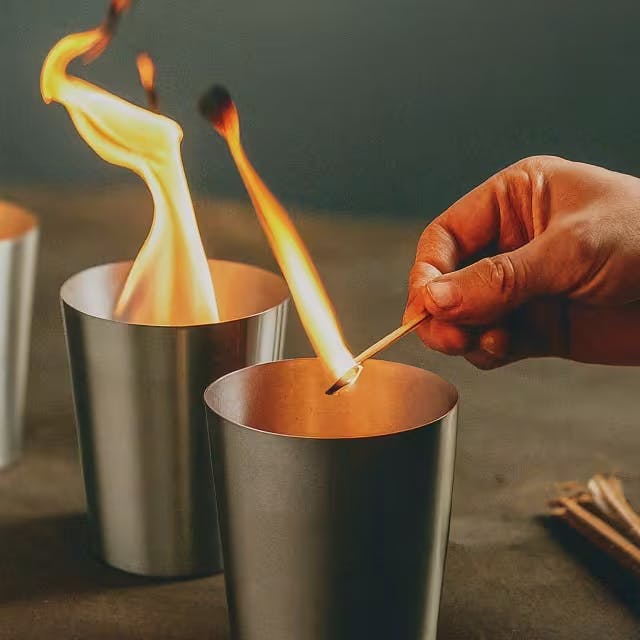Candle Cup Designs for Metalworking Projects
Abana Chapter
March 20, 2024

Diving into the world of metalworking projects offers a unique opportunity to blend creativity with functionality, especially when exploring the realm of candle cup designs. Whether you're a novice craftsman or a seasoned artist, understanding the fundamentals of crafting candle cups can elevate your projects, adding a refined touch to your décor or serving as thoughtful, handmade gifts. This article provides a comprehensive guide on candle cup designs for metalworking projects, ensuring you have the knowledge and inspiration to start your journey into this captivating aspect of metal artistry.
Key Takeaways
Understanding the basics of candle cup design is crucial for incorporating uniqueness and functionality into your metalworking projects.
A step-by-step guide can simplify the process of crafting your first metal candle cup, making it accessible to novices and inspirational for seasoned artists.
Exploring innovative metal candle cup styles can modernize your décor, offering fresh ideas for those looking to add a contemporary touch.
Selecting the right materials is vital for the success of the project, impacting both the aesthetic appeal and longevity of the candle cups.
Implementing best practices in metal candle cup fabrication is essential for maximizing durability and ensuring your creations withstand the test of time.

Exploring the Basics of Candle Cup Design in Metalworking
When embracing the art of metalworking for creating candle cups, understanding the basics of design can spark creativity and ensure functionality. Design varies widely, from simple, classic shapes to more elaborate and decorative pieces that add flair to any setting. Key considerations include size, which should accommodate common candle dimensions while providing stability, and material, which can range from copper and brass to wrought iron, each offering a unique aesthetic and thermal conductivity.
For beginners, starting with straightforward designs and experimenting with embellishments like hammered finishes or cut-outs can be rewarding. Ensuring the metal is properly worked to avoid sharp edges that could pose a safety hazard is crucial. Tools like swages and fullers are indispensable in achieving precise shapes and textures.
For those looking to dive deeper into the specifics of metalworking tools, exploring resources on swages and fullers can provide valuable insights.
Additionally, selecting the right hammer directly impacts the quality and ease of your metalworking projects. Discovering the ideal hammer for metal forging is essential for both novices and seasoned craftsmen alike.
By blending practical considerations with artistic expression, metalworkers can craft candle cup designs that not only serve a functional purpose but also add a touch of handmade beauty to any space. Whether opting for minimalist elegance or intricate patterns, the key to a successful project lies in the precision of the metalwork and the creativity of the design.
Crafting Your First Metal Candle Cup: A Step-By-Step Guide
Metalworking can seem daunting, especially when trying something new like crafting a candle cup. Yet, with a step-by-step guide, you'll find it's a rewarding endeavor that beautifully marries function with artistry. Let's break down the process into manageable steps:
Choosing Your Metal: Start by selecting the metal you wish to work with. Options such as copper, brass, and stainless steel offer different aesthetics and functionalities. Each metal responds differently to heat and manipulation, so take some time to research or consult resources like this comprehensive guide on raw materials for blacksmithing and metalwork.
Design Planning: Sketch your candle cup design, considering factors like size, shape, and any decorative patterns you might want to incorporate. If you're new to designing, simple cylindrical or box shapes are a great starting point. Experimenting with basic techniques in repoussé and chasing can add flair to your projects.
Cutting Your Metal: Using the right tools for cutting your metal is crucial. This might involve shears, saws, or other cutting tools. Ensure your pieces are sized according to your design plan.
Shaping and Forming: Once your metal pieces are cut, it's time for shaping. This can be done through hammering, bending, and using various types of vises to hold your workpiece. If your design is more intricate, consider tools like precision duckbill tongs for more detailed work.
Joining Pieces Together: Depending on your design, you might need to solder or weld parts together. For those new to this, simple mechanical joining methods like riveting are a great place to start. There's no shame in beginning with basics; mastery comes with time and practice.
Finishing Touches: The final step involves cleaning up your piece and adding any finishes such as polishing, patinating, or applying a protective coating. This not only enhances the visual appeal of your candle cup but also protects the metal from tarnishing.
Remember, the key to success in metalworking is patience and practice. Don't be discouraged by initial challenges. Take each project as a learning opportunity, gradually expanding your skills and creativity. For further inspiration and tips, diving into resources like this beginner's guide to metalworking can offer invaluable advice and encouragement.

Innovative Metal Candle Cup Styles for Modern Decor
For enthusiasts and professionals keen on blending function with aesthetic in their metalworking projects, exploring diverse candle cup designs presents a fresh avenue. With an emphasis on both creativity and functionality, these designs not only enhance modern decor but also invite a personal touch to any space.
Geometric Forms: Think beyond traditional round candle cups. Shapes like hexagons, squares, and even abstract forms can add a modern twist. Each shape offers a different glow and shadow play, adding depth to your decor.
Textured Finishes: Incorporating textures such as hammered, brushed, or patinated finishes gives candle cups an artisanal quality. These textures catch light uniquely, providing a warm, inviting atmosphere.
Mixed Materials: Combining metal with other materials like glass, wood, or stone can elevate a candle cup's design. This blend not only adds visual interest but also versatility in styling across various decor themes.
Eco-friendly Designs: In an age where sustainability is key, using recycled metals or incorporating designs that use less material without compromising on strength or aesthetics speaks volumes. It’s a thoughtful approach that adds story and value to your creations.
For those already dabbling in metal art or considering it, integrating candle cup projects can serve as a delightful exploration of form and function. For more insights and inspiration on crafting with metal, consider diving into resources that explore creative blacksmithing ideas or the latest trends in innovative metal art materials and projects. These guides can provide not only technical knowledge but also inspire with new project ideas, ensuring your next creation not only brightens spaces but also ignites your passion for metalworking.
Tips for Selecting the Right Materials for Metal Candle Cups
When diving into creating metal candle cups, selecting the right materials not only impacts the final aesthetic but also functionality and safety. Metals such as copper, brass, stainless steel, and aluminum are popular for their varying colors, weights, and thermal properties. Here's a quick guide:
Copper: Offers a classic look with its warm hue, perfect for traditional or rustic designs. It has excellent thermal conductivity, making it a swift conductor of heat.
Brass: Similar to copper in color but with added durability and corrosion resistance. Its polished surface gives a luxurious finish to any candle cup design.
Stainless Steel: Known for its strength and resistance to rust and tarnishing. This material provides a modern look and is ideal for contemporary candle cup designs.
Aluminum: Lightweight and cost-effective, aluminum is easy to mold into intricate shapes. However, it has a higher thermal conductivity, so caution is needed when handling.
Each material has its unique properties that can influence the crafting process and the final product's look and feel. For example, working with high-quality rounding hammers for smithing improves the shaping of these metals, enhancing the artistic expression in your metalworking project. It's also crucial to consider the heat resistance of each material, ensuring the safety and longevity of the candle cup.
In summary, choosing the right material for your metal candle cups depends on the desired aesthetic, the functionality requirements, and, importantly, the safety aspects related to heat conduction. With the right tools and materials, your metalworking project can illuminate spaces with both beauty and warmth.

Maximizing Durability: Best Practices for Metal Candle Cup Fabrication
Creating durable and visually appealing candle cups for metalworking projects involves several key considerations. Material choice is paramount; opting for high-quality metals ensures longevity and resistivity against heat and corrosion. For example, stainless steel and copper are excellent choices due to their heat tolerance and aesthetic appeal. Additionally, applying appropriate metal finishing techniques not only enhances the appearance but also provides an extra layer of protection against wear and tear.
Precision in craftsmanship is crucial. Tools play a significant role in achieving this, so selecting the right cutting tools for anvil hardy in your metalwork can make a significant difference in the outcome. Proper maintenance of these tools ensures they remain sharp and effective, allowing for intricate designs and smooth finishes.
Another aspect to consider is the incorporation of sustainable practices within the fabricating process. Integrating eco-friendly materials or recycled metals can greatly reduce the environmental footprint of your metalworking project without compromising the quality or durability of your candle cups.
By prioritizing quality materials, finishing techniques, precision tools, and sustainable practices, you can create candle cup designs that are both beautiful and built to last. Embarking on the journey of creating candle cup designs for metalworking projects opens up a realm of artistic and practical possibilities. By paying close attention to the type of metal, the intricacies of design, and the quality of fabrication, hobbyists and professionals alike can craft candle cups that are not only functional but also enhance the aesthetics of any space. With a variety of materials, techniques, and styles at one's disposal, the journey from a beginner's simple project to intricate, modern designs promises a rewarding experience that combines the elegance of metal art with the warmth of candlelight.
Frequently Asked Questions
What are the best metals for creating durable candle cups?
For creating durable and aesthetically pleasing candle cups, the best metals include stainless steel, copper, brass, and aluminum. Stainless steel offers exceptional strength and resistance to rust, making it ideal for contemporary designs. Copper and brass not only provide a classic look with their warm hues but also offer good thermal conductivity, suitable for traditional or rustic aesthetics. Aluminum, being lightweight and cost-effective, allows for intricate designs but requires careful handling due to its high thermal conductivity. Each material adds a unique touch to the candle cups, enhancing their functionality and style.
How can beginners add unique textures to their metal candle cup designs?
Beginners can add unique textures to their metal candle cup designs by experimenting with hammered finishes or cut-outs, using tools like swages and fullers for precise texture, and exploring various hammers for unique impacts on the metal's surface. Ensuring the metal is properly shaped to avoid sharp edges is also critical for both safety and aesthetics.
What are the essential tools for shaping and forming metal in candle cup projects?
Essential tools for shaping and forming metal in candle cup projects include:
Hammers and Mallets: Vital for shaping and adding texture.
Swages and Fullers: For achieving precise shapes, curves, and contours.
Shears and Saws: Necessary for cutting metal to size.
Vises and Tongs: To securely hold and manipulate the metal while working.
Soldering or Welding Equipment: For joining metal pieces together smoothly.
Choosing the right toolset is crucial for both the functionality and aesthetics of your metal candle cups, enhancing the crafting process and final outcome.
How do finishing touches enhance the appearance and durability of metal candle cups?
Finishing touches significantly enhance the appearance and durability of metal candle cups by providing a polished look and protective layer against tarnishing. Techniques such as polishing, patinating, or applying a protective coating not only improve visual appeal but also ensure the metal withstands regular use and heat exposure. These final steps in the metalworking process solidify the craftsmanship and aesthetic value of the piece, making it a functional and decorative asset.
Why is it important to consider heat resistance in selecting materials for metal candle cups?
Considering heat resistance when selecting materials for metal candle cups is essential for ensuring the safety and functionality of the final product. Materials with high heat tolerance prevent warping and potential hazards when the candle is lit. Metals like stainless steel, brass, and copper offer not only aesthetic diversity but also vary in their heat conduction properties, making it crucial to choose based on both design intent and safety considerations.


